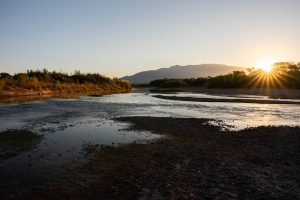
You’d be forgiven for thinking that the Grand Prismatic Spring in Yellowstone National Park, USA, is photoshopped. It isn’t. True story. You know what does lie behind its vibrant colours, though? Science.
Without getting too technical, its stunning prismatic colour, matching most of the colours seen in the rainbow dispersion of white light by an optical prism – red, orange, yellow, green, and blue – is actually all thanks to the heat-loving bacteria living within this red-hot spring.
The spring was first officially described, and named, by the Hayden Expedition in 1871, on the first federally-funded exploration of what would later become known as Yellowstone National Park. Of the spring, Ferdinand Hayden, the expedition’s leader, wrote: “Nothing ever conceived by human art could equal the peculiar vividness and delicacy of colour of these remarkable prismatic springs. Life becomes a privilege and a blessing after one has seen and thoroughly felt these incomparable types of nature’s cunning skill.”
Nature’s cunning skill indeed. For what Nature has created here is not only the largest hot spring in the United States, and the third largest in the world, after Frying Pan Lake in New Zealand and Boiling Lake in Dominica, but a vividly coloured marvel that has to be seen to be believed.
Created by microbial mats around the edges of the mineral-rich water, the colour also changes with the seasons: in the summer, the mats tend to be orange and red, whereas in the winter they are usually dark green. Pick your season to see your favourite colour combo. As for that magnetic, luminous blue centre? That is thanks to the spring’s extreme depth, combined with extreme heat, causing a completely sterile environment, perfect for the purest of colours.
Located at Yellowstone’s Midway Geyser Basin, at 160 feet (50 metres) deep and 370 feet (110 metres) in diameter, the magical rainbow-hued Grand Prismatic Spring is deeper than a 10-story building and bigger than a football field. It’s also far more than just a pretty face: the thermophile microbes living in this thermal pool have helped investigators solve crimes and NASA search for extraterrestrial life on seemingly inhospitable planets. Case in point: in 1968, researcher Thomas Brock discovered a microbe living here which has, in the years of research since, led to major medical and scientific advances, including the sequencing of the entire human genome.
You can find the Midway Geyser Basin, and the Grand Prismatic Spring, a short distance north from the Old Faithful area of Yellowstone National Park: from the West Entrance, drive about 40 kilometres on the West Entrance Road and Grand Loop Road to the Midway Geyser Basin parking area.
If you have a really special photograph you would like to share with A Luxury Travel Blog‘s readers, please contact us.





